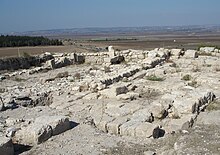

| Christian eschatology |
|---|
| Christianity portal |
According to the Book of Revelation in the New Testament of the Christian Bible, Armageddon (/ˌɑːrməˈɡɛdən/; Ancient Greek: Ἁρμαγεδών Harmagedṓn;[1][2] Late Latin: Armagedōn;[3] from Hebrew: הַר מְגִדּוֹ Har Məgīddō) is the prophesied location of a gathering of armies for a battle during the end times, which is variously interpreted as either a literal or a symbolic location. The term is also used in a generic sense to refer to any end-of-the-world scenario. In Islamic theology, Armageddon is also mentioned in Hadith as the Greatest Armageddon or Al-Malhama Al-Kubra (the great battle).[4]
The "mount" of Megiddo in northern Israel is not actually a mountain, but a tell (a mound or hill created by many generations of people living and rebuilding at the same spot)[5] on which ancient forts were built to guard the Via Maris, an ancient trade route linking Egypt with the northern empires of Syria, Anatolia and Mesopotamia. Megiddo was the location of various ancient battles, including one in the 15th century BC and one in 609 BC. The nearby modern Megiddo is a kibbutz in the Kishon River area.[6]
- ^ "Bibletranslation.ws" (PDF). bibletranslation.ws. Archived (PDF) from the original on 2011-07-16. Retrieved 2009-09-23.
- ^ "Revelation 16:16 And they assembled the kings in the place that in Hebrew is called Armageddon". biblehub.com. Archived from the original on 2012-10-27. Retrieved 2019-04-01.
- ^ Collins English Dictionary, HarperCollins, 3rd ed., p. 81
- ^ "Hadith - Book of Tribulations - Sunan Ibn Majah - Sunnah.com - Sayings and Teachings of Prophet Muhammad (صلى الله عليه و سلم)". sunnah.com. Archived from the original on 2020-11-12. Retrieved 2020-12-24.
- ^ "Amateur Archaeologists Get the Dirt on the Past" Archived 2021-03-08 at the Wayback Machine, The New York Times
- ^ "Maps and pictures of Megiddo mountain and the surrounding plain (in Spanish)". www.bloganavazquez.com. Archived from the original on 2017-06-14. Retrieved 2010-06-22.